Sorption of Phosphate on Douglas Fir Biochar Treated with Magnesium Chloride and Potassium Hydroxide for Soil Amendments
Abstract
1. Introduction
2. Materials and Methods
2.1. Source of Biochar Used
2.2. Preparation of Modified Biochar (MBK)
2.2.1. Preparation of Magnesium Chloride Modified Douglas Fir Biochar (MB)
2.2.2. Preparation Modified Biochar (MBK) from MB
2.3. Characterization of Biochar
2.3.1. Surface Analysis
Determination of Surface Morphology, Structural Chemical Composition, and Functional Groups
2.3.2. Phosphate Adsorption Study
2.3.3. Determining the Point of Zero Charge (pHpzc)
2.3.4. Kinetic Studies
2.3.5. Isotherm Studies
2.4. P Sorption by Biochar Soil Mixture
3. Results and Discussions
3.1. BET Surface Analysis
3.2. Surface Morphology, Structural Chemical Composition, and Functional Groups Determination
3.3. Sorption of Phosphate on MBK
3.3.1. Point of Zero Charge (pHpzc)
3.3.2. Sorption Kinetics
3.3.3. Sorption Isotherms
3.4. P Retention and Availability in Soil

4. Conclusions
Author Contributions
Funding
Data Availability Statement
Acknowledgments
Conflicts of Interest
Abbreviations
| ATR-FTIR | Attenuated total reflectance Fourier Transformed Infrared Spectroscopy |
| BET | Brunner–Emmet–Teller |
| DFB | Douglas fir biochar |
| EDX | Energy dispersive spectroscopy |
| MB | Magnesium chloride modified Douglas fir biochar |
| MBK | Magnesium chloride plus potassium hydroxide modified Douglas fir biochar |
| PEM | P-enriched biochar (post sorption MBK) |
| pHpzc) | pH point of zero charge |
| SEM | Scanning electron microscopy |
| US EPA | United States Environmental Protection Agency |
| XRD | X-ray diffraction |
References
- Ngatia, L.W.; Hsieh, Y.P.; Nemours, D.; Fu, R.; Taylor, R.W. Potential Phosphorus Eutrophication Mitigation Strategy: Biochar Carbon Composition, Thermal Stability and PH Influence Phosphorus Sorption. Chemosphere 2017, 180, 201–211. [Google Scholar] [CrossRef] [PubMed]
- Kim, K.; Vikrant, K.; Kim, K.; Sik, Y.; Tsang, D.C.W.; Fai, Y. Engineered/Designer Biochar for the Removal of Phosphate in Water and Wastewater. Sci. Total Environ. 2017, 616, 1242–1260. [Google Scholar] [CrossRef]
- Geoghegan, E.K.; Cardon, Z.; Vallino, J.J. Decomposition and Methane Production in Anaerobic Environments: A Case Study in a Methanogenic Bioreactor; 2016; pp. 1–20. Available online: https://scholar.google.com/citations?view_op=view_citation&hl=en&user=6kfVFL4AAAAJ&citation_for_view=6kfVFL4AAAAJ:Y0pCki6q_DkC (accessed on 4 June 2020).
- Keplinger, K.O.; Houser, J.B.; Tanter, A.M.; Hauck, L.M.; Beran, L. Cost and Affordability of Phosphorus Removal at Small Wastewater. Available online: https://p2infohouse.org/ref/34/33892.pdf (accessed on 4 June 2020).
- Litke, D.W. Review of Phosphorus Control Measures in the United States and Their Effects on Water Quality; US Department of the Interior, US Geological Survey: Washington, DC, USA, 1999.
- Ogonek, P. Phosphorus Adsorption through Engineered Biochars Produced from Local Waste Products; University of Dayton: Dayton, OH, USA, 2016. [Google Scholar]
- Torabian, S.; Qin, R.; Noulas, C.; Lu, Y.; Wang, G. Biochar: An organic amendment to crops and an environmental solution. AIMS Agric. Food 2021, 6, 401–415. [Google Scholar] [CrossRef]
- Yang, X.; Zhang, S.; Ju, M.; Liu, L. Preparation and Modification of Biochar Materials and Their Application in Soil Remediation: Review. Appl. Sci. 2019, 9, 1365. [Google Scholar] [CrossRef]
- Genon, J.G.; de Hepcee, N.; Duffy, J.E.; Delvaux, B.; Hennebert, P.A. Iron Toxicity and Other Chemical Soil Constraints to Rice in Highland Swamps of Burundi. Plant Soil 1994, 166, 109–115. [Google Scholar] [CrossRef]
- Panda, S.K.; Baluska, F.; Matsumoto, H. Aluminum Stress Signaling in Plants. Plant Signal. Behav. 2009, 4, 592–597. [Google Scholar] [CrossRef]
- Onyango, D.A.; Entila, F.; Dida, M.M.; Ismail, A.M.; Drame, K.N. Mechanistic Understanding of Iron Toxicity Tolerance in Contrasting Rice Varieties from Africa: 1. Morpho-Physiological and Biochemical Responses. Funct. Plant Biol. 2019, 46, 93–105. [Google Scholar] [CrossRef]
- Jaiswal, S.K.; Naamala, J.; Dakora, F.D. Nature and Mechanisms of Aluminium Toxicity, Tolerance and Amelioration in Symbiotic Legumes and Rhizobia. Biol. Fertil. Soils 2018, 54, 309–318. [Google Scholar] [CrossRef]
- Tripathi, D.K.; Singh, S.; Singh, S.; Mishra, S.; Chauhan, D.K.; Dubey, N.K. Micronutrients and their diverse role in agricultural crops: Advances and future prospective. Acta Physiol. Plant. 2015, 37, 1–14. [Google Scholar] [CrossRef]
- Jiang, S.Y.N. Adsorption of Phosphorus by Modified Clay Mineral Waste Material Relating to Removal of It from Aquatic System. Int. J. Environ. Monit. Anal. 2014, 2, 36. [Google Scholar] [CrossRef]
- Nierves, M.C.P.; Salas, F.M. Assessment of Soil Phosphorus and Phosphorus Fixing Capacity of Three Vegetable Farms at Cabintan, Ormoc City, Leyte. World J. Agric. Res. 2015, 3, 70–73. [Google Scholar] [CrossRef]
- Akgül, G.; Maden, T.B.; Diaz, E.; Jiménez, E.M. Modification of Tea Biochar with Mg, Fe, Mn and Al Salts for Efficient Sorption of PO3-4 and Cd2+ from Aqueous Solutions. J. Water Reuse Desalin. 2019, 9, 57–66. [Google Scholar] [CrossRef]
- Yao, Y.; Gao, B.; Chen, J.; Yang, L. Engineered Biochar Reclaiming Phosphate from Aqueous Solutions: Mechanisms and Potential Application as a Slow-Release Fertilizer. Environ. Sci. Technol. 2013, 47, 8700–8708. [Google Scholar] [CrossRef] [PubMed]
- Takaya, C.A.; Fletcher, L.A.; Singh, S.; Okwuosa, U.C.; Ross, A.B. Recovery of Phosphate with Chemically Modified Biochars. J. Environ. Chem. Eng. 2016, 4, 1156–1165. [Google Scholar] [CrossRef]
- Fang, C.; Zhang, T.; Li, P.; Jiang, R.F.; Wang, Y.C. Application of Magnesium Modified Corn Biochar for Phosphorus Removal and Recovery from Swine Wastewater. Int. J. Environ. Res. Public Health 2014, 11, 9217–9237. [Google Scholar] [CrossRef]
- Uchida, R. Essential Nutrients for Plant Growth. In Plant Nutrient Management in Hawaii’s Soils, Approaches for Tropical and Subtropical Agriculture; Silva, J.A., Uchida, R., Eds.; College of Tropical Agriculture and Human Resources, University of Hawaii at Manoa: Honolulu, HI, USA, 2000; pp. 31–55. [Google Scholar]
- Millaleo, R.; Ivanov, A.G.; Mora, M.L.; Alberdi, M. Manganese as Essential and Toxic Element for Plants: Transport, Accumulation and Resistance Mechanisms. J. Soil Sci. Plant Nutr. 2010, 10, 476–494. [Google Scholar] [CrossRef]
- Rout, G.; Samantaray, S.; Das, P. Aluminium Toxicity in Plants: A Review. Agronomie 2001, 21, 3–21. [Google Scholar] [CrossRef]
- Lauricella, D.; Butterly, C.; Tang, C. Comparison of a Range of Amendments on Alleviating Al and Mn Toxicity in Wheat. Managing SubsoilL Acidity (GRDC DAN00206); 2017. Available online: https://www.dpi.nsw.gov.au/__data/assets/pdf_file/0004/735430/subsoil-factsheet-no.6-ltu-oa.pdf (accessed on 4 June 2020).
- Vlamis, J.; Williams, D.E. Liming Reduces Alluminium and Magnese Toxicity in Acid Soils. Available online: http://calag.ucanr.edu/Archive/?article=ca.v016n09p6 (accessed on 18 April 2020).
- Yao, Y.; Gao, B.; Inyang, M.; Zimmerman, A.R.; Cao, X.; Pullammanappallil, P.; Yang, L. Removal of Phosphate from Aqueous Solution by Biochar Derived from Anaerobically Digested Sugar Beet Tailings. J. Hazard. Mater. 2011, 190, 501–507. [Google Scholar] [CrossRef]
- Karunanayake, A.G.; Navarathna, C.M.; Gunatilake, S.R.; Crowley, M.; Anderson, R.; Mohan, D.; Perez, F.; Pittman, C.U.; Mlsna, T. Fe3O4 Nanoparticles Dispersed on Douglas Fir Biochar for Phosphate Sorption. ACS Appl. Nano Mater. 2019, 2, 3467–3479. [Google Scholar] [CrossRef]
- Premalatha, R.; Parameswari, E.; Malarvizhi, P.; Avudainayagam, S.; Davamani, V. Sequestration of Hexavalent Chromium from Aqueous Medium Using Biochar Prepared from Water Hyacinth Biomass. Chem. Sci. Int. J. 2018, 22, 1–15. [Google Scholar] [CrossRef]
- Kose, R.; Miyanishi, T.; Okayama, T.; Phuong, M.; Thi, D. Pore Characteristics & Adsorption Capacities of Biochars Derived from Rice Residues as Affected by Variety and Pyrolysis Temperature. Am. J. Innov. Res. Appl. Sci. 2016, 2, 179–189. [Google Scholar]
- Fahmi, A.H.; Samsuri, A.W.; Jol, H.; Singh, D. Physical Modification of Biochar to Expose the Inner Pores and Their Functional Groups to Enhance Lead Adsorption. RSC Adv. 2018, 8, 38270–38280. [Google Scholar] [CrossRef] [PubMed]
- Dehkhoda, A.M.; Ellis, N.; Gyenge, E. Electrosorption on Activated Biochar: Effect of Thermo-Chemical Activation Treatment on the Electric Double Layer Capacitance. J. Appl. Electrochem. 2014, 44, 141–157. [Google Scholar] [CrossRef]
- Siburian, R.; Sihotang, H.; Lumban Raja, S.; Supeno, M.; Simanjuntak, C. New Route to Synthesize of Graphene Nano Sheets. Orient. J. Chem. 2018, 34, 182–187. [Google Scholar] [CrossRef]
- Ishizawa, N.; Setoguchi, H.; Yanagisawa, K. Structural evolution of calcite at high temperatures: Phase v unveiled. Sci. Rep. 2013, 3, 9–11. [Google Scholar] [CrossRef]
- Yi, M.; Chen, Y. Enhanced Phosphate Adsorption on Ca-Mg-Loaded Biochar Derived from Tobacco Stems. Water Sci. Technol. 2018, 78, 2427–2436. [Google Scholar] [CrossRef]
- Nagai, T.; Hattori, T.; Yamanaka, T. Compression mechanism of brucite: An investigation by the structural refinement under pressure Sample: P = 2.5 GPa. Am. Miner. 2000, 85, 760–764. Available online: http://www.crystallography.net/cod/9002349.html (accessed on 4 June 2020). [CrossRef]
- Xie, F.; Wu, F.; Liu, G.; Mu, Y.; Feng, C.; Wang, H. Removal of Phosphate from Eutrophic Lakes through Adsorption by in Situ Formation of Magnesium Hydroxide from Diatomite. Environ. Sci. Technol. 2013, 48, 582–590. [Google Scholar] [CrossRef]
- Schroeder, L.W.; Mathew, M.; Brown, W.E. XO4n- ion hydration. The crystal structure of magnesium phosphate docosahydrate. J. Phys. Chem. 1978, 82, 2335–2340. [Google Scholar] [CrossRef]
- Qian, C.X.; Sun, L.Z.; Yu, X.N. Chemosynthesis of Nano-Magnesium Phosphates and Its Characterization. Dig. J. Nanomater. Biostruct. 2016, 11, 1099–1103. [Google Scholar]
- Lustosa Filho, J.F.; Penido, E.S.; Castro, P.P.; Silva, C.A.; Melo, L.C.A. Co-Pyrolysis of Poultry Litter and Phosphate and Magnesium Generates Alternative Slow-Release Fertilizer Suitable for Tropical Soils. ACS Sustain. Chem. Eng. 2017, 5, 9043–9052. [Google Scholar] [CrossRef]
- Dhananasekaran, S.; Palanivel, R.; Pappu, S. Adsorption of Methylene Blue, Bromophenol Blue, and Coomassie Brilliant Blue by α-Chitin Nanoparticles. J. Adv. Res. 2016, 7, 113–124. [Google Scholar] [CrossRef] [PubMed]
- Kajjumba, G.W.; Emik, S.; Öngen, A.; Kurtulus Özcan, H.; Aydın, S. Modelling of Adsorption Kinetic Processes—Errors, Theory and Application. Adv. Sorpt. Process Appl. 2018. [Google Scholar] [CrossRef]
- Nguyen, T.H.; Pham, T.H.; Nguyen Thi, H.T.; Nguyen, T.N.; Nguyen, M.V.; Tran Dinh, T.; Nguyen, M.P.; Do, T.Q.; Phuong, T.; Hoang, T.T.; et al. Synthesis of Iron-Modified Biochar Derived from Rice Straw and Its Application to Arsenic Removal. J. Chem. 2019, 2019, 5295610. [Google Scholar] [CrossRef]
- Barak, P. Macronutrients and Micronutrients. Available online: https://soils.wisc.edu/facstaff/barak/soilscience326/macronut.htm (accessed on 20 June 2020).
- Li, M.; Liu, J.; Xu, Y.; Qian, G. Phosphate Adsorption on Metal Oxides and Metal Hydroxides: A Comparative Review. Environ. Rev. 2016, 24, 319–332. [Google Scholar] [CrossRef]
- Foo, K.Y.; Hameed, B.H. Insights into the Modeling of Adsorption Isotherm Systems. Chem. Eng. J. 2010, 156, 2–10. [Google Scholar] [CrossRef]
- Zhou, L.; Zhu, D.; Zhang, S.; Pan, B.; Hu, X.; He, M.; Li, S.; Wei, Y.; Chen, Z.; Wu, F.; et al. Phosphorus Recovery from Biogas Fermentation Liquid by Ca–Mg Loaded Biochar. J. Environ. Sci. 2015, 29, 106–114. [Google Scholar]
- Everaert, M.; Warrinnier, R.; Baken, S.; Gustafsson, J.-P.; De Vos, D.; Smolders, E. Phosphate-Exchanged Mg-Al Layered Double Hydroxides: A New Slow Release Phosphate Fertilizer. ACS Sustain. Chem. Eng. 2016, 4, 4280–4287. [Google Scholar] [CrossRef]
- Hainje, D. Phosphorus Retention in a Variety of Soils Amended with Biochar or Fe-Coated Biochar. In GSA Annual Meeting in Indianapolis, Indiana, USA—2018); Geological Society of America Abstracts with Programs: Indianapolis, Indiana, 2018; Volume 50, p. 95-25. [Google Scholar] [CrossRef]
- Xu, G.; Wei, L.L.; Sun, J.N.; Shao, H.B.; Chang, S.X. What Is More Important for Enhancing Nutrient Bioavailability with Biochar Application into a Sandy Soil: Direct or Indirect Mechanism? Ecol. Eng. 2013, 52, 119–124. [Google Scholar] [CrossRef]
- Hovi, J.; Soinne, H.; Tammeorg, P.; Turtola, E.; Helenius, J. Phosphorus Sorption in Biochar Amended Soils. In Proceedings of the 2nd Nordic Biochar Seminar, Helsinki, Finland, 14–15 February 2013; p. 50. [Google Scholar]
- Fariha, N.; Idrus, M.; Jamion, N.A.; Omar, Q.; Ahmad, S.; Sheikh, I.; Majid, Z.A.; Yong, S.K. Magnesium-Impregnated Biochar for the Removal of Total Phosphorous from Artificial Human Urine. Int. J. Eng. Technol. 2018, 7, 218–222. [Google Scholar] [CrossRef]
- Bolland, M.D.A.; Allen, D.G.; Barrow, N.J. Sorption of Phosphorus by Soils: How It Is Measured in Western Australia; Bulletin 4591; Department of Primary Industries and Regional Development: Perth, Australia, 2003; p. 4591. [Google Scholar]
- Bohn, H.L.; Myer, R.A.; George, A.O. Soil Chemistry; John Wiley & Sons: Hoboken, NJ, USA, 2002. [Google Scholar]
- Abebe, M. Nature and Management of Acids Soils in Ethiopia. Available online: http://hdl.handle.net/123456789/2185 (accessed on 31 July 2020).
- Idris, O.A.A.; Ahmed, H.S. Phosphorus Sorption Capacity as a Guide for Phosphorus Availability of Selected Sudanese Soil Series. Afr. Crop Sci. J. 2012, 20, 59–65. [Google Scholar]

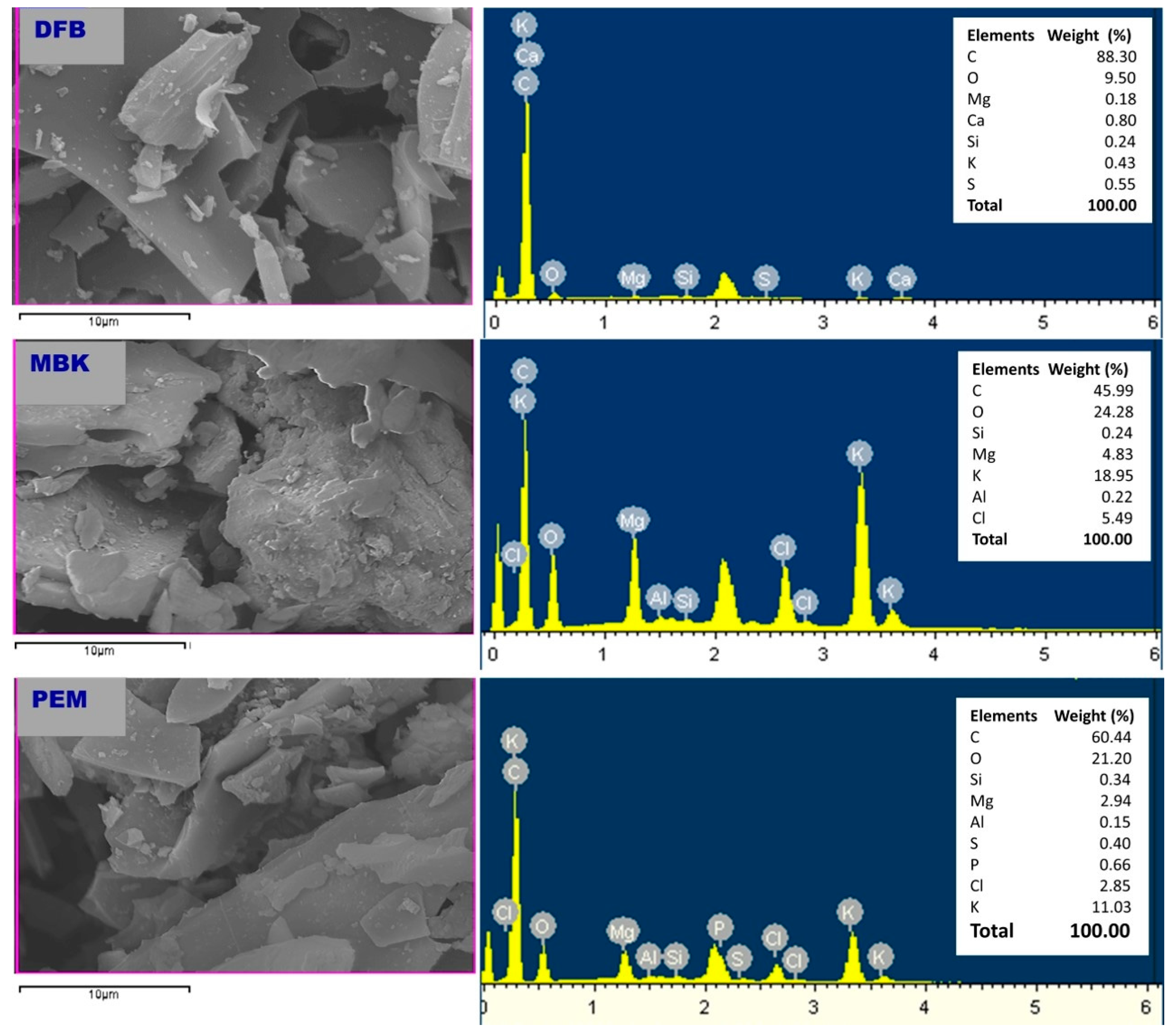

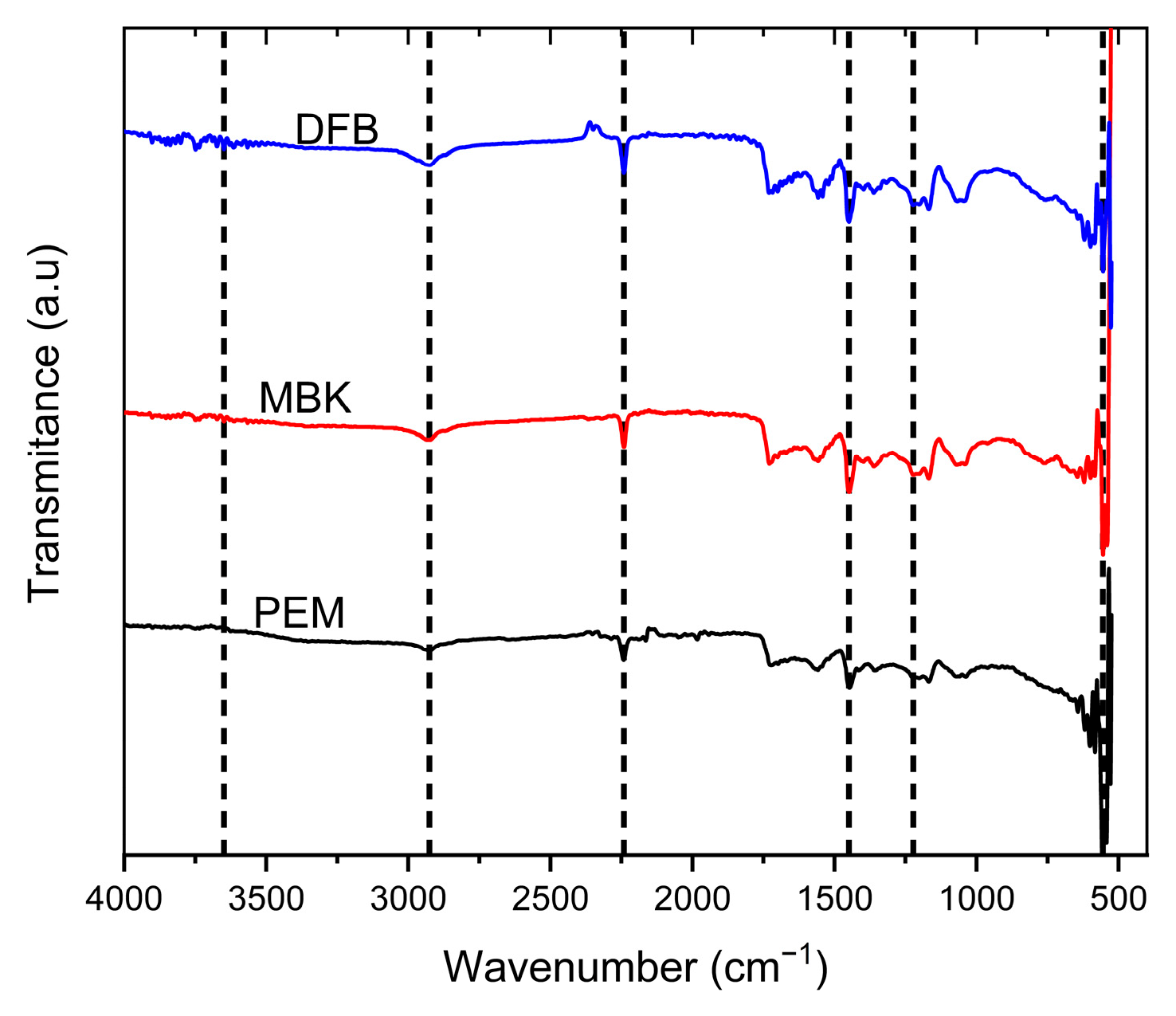

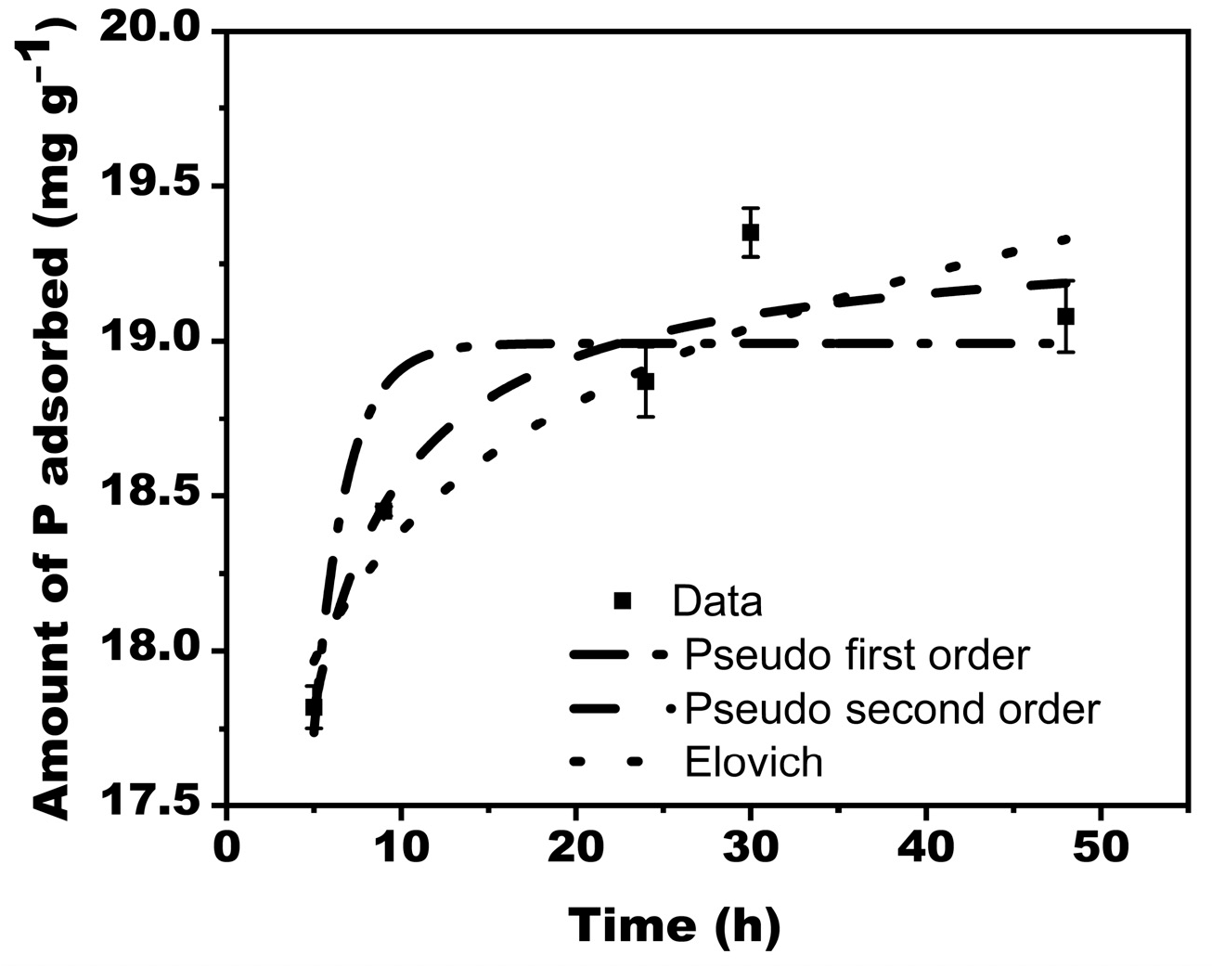
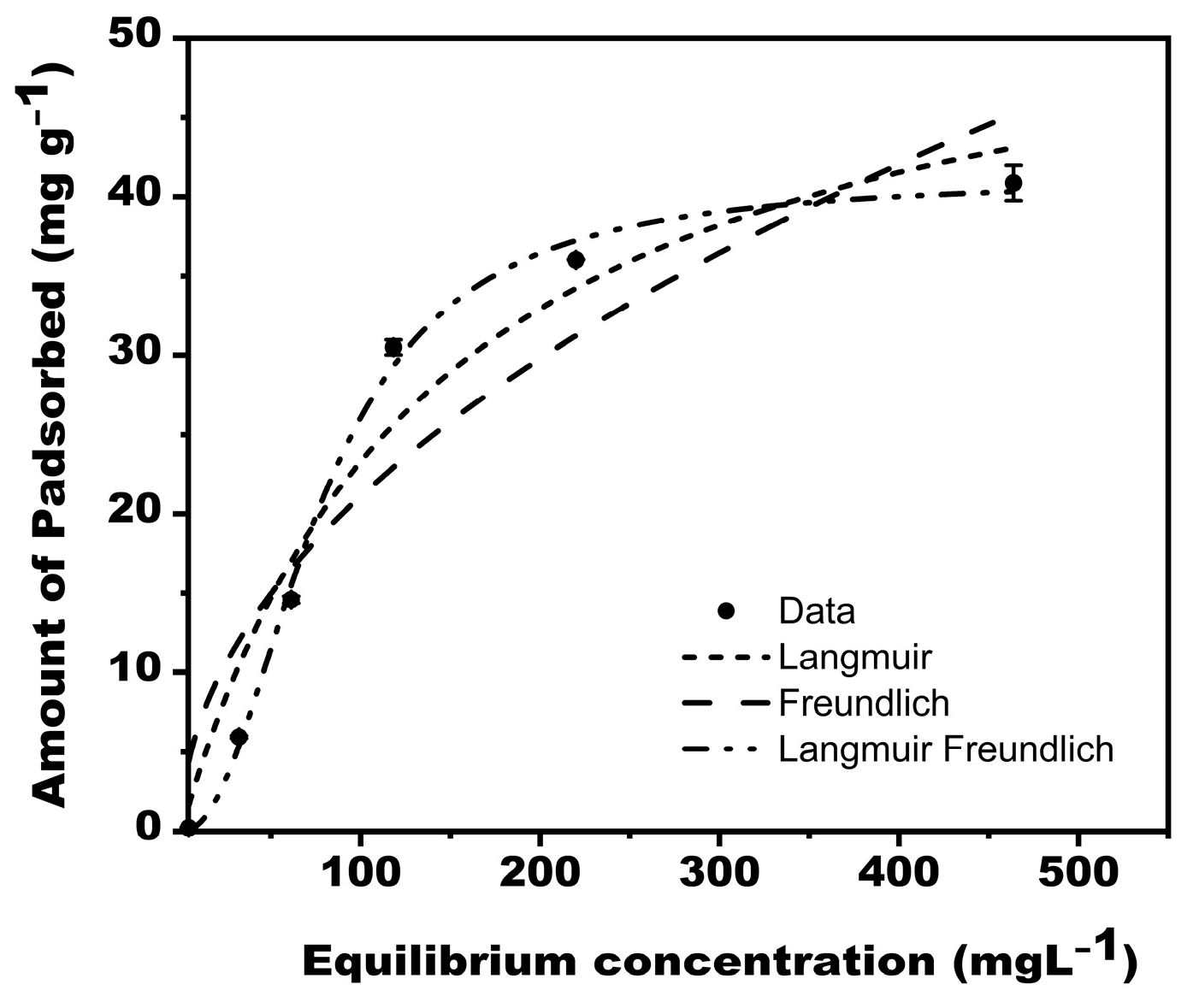
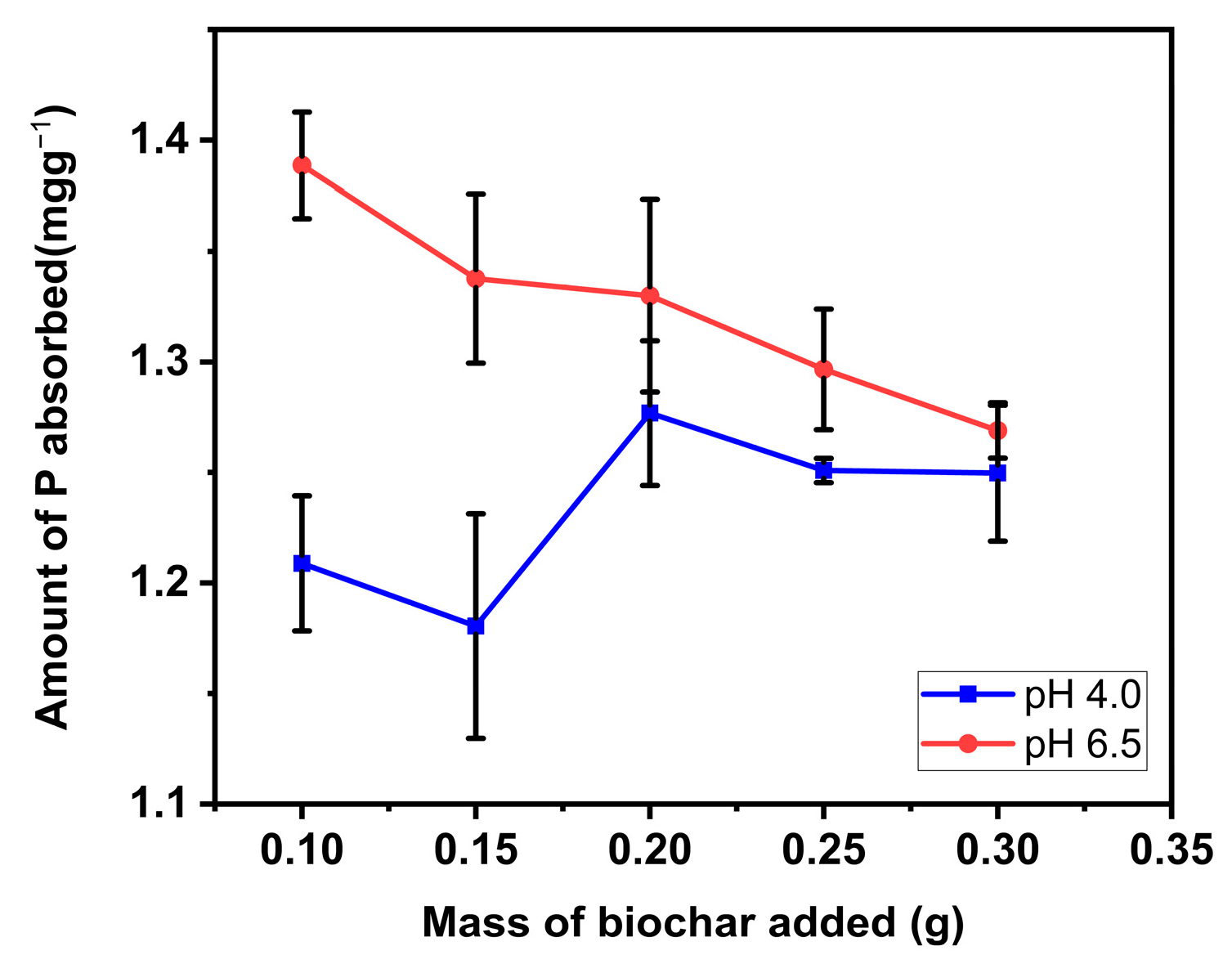

| Sample | BET Surface Area (m2 g−1) | Adsorption Average Pore Diameter (Å) | Total Pore Volume (cm3 g−1) |
|---|---|---|---|
| MBK | 2.39 | 26.08 | 0.001 |
| PEM | 137.23 | 12.72 | 0.048 |
| DFB | 528.10 | 2.70 | 0.042 |
| Model | k1 (h−1) or k2 (gmg−1h−1) | qe (mgg−1) | R2 |
|---|---|---|---|
| Pseudo-first-order kinetics | 0.54 | 18.99 | 0.78 |
| Elovich | - | - | 0.86 |
| Pseudo-second-order kinetics | 0.12 | 19.36 | 0.93 |
| Model | KL (L/mg) | KF (mg(1−n) Lng−1 | n | Q(mg/g) | R2 | Adjusted R2 |
|---|---|---|---|---|---|---|
| Langmuir | 0.00709 | - | - | 56.16 | 0.957 | 0.947 |
| Freundlich | - | 2.14176 | 2.01272 | - | 0.888 | 0.861 |
| Langmuir –Freundlich | - | 2.15078 | 41.19 | 0.997 | 0.995 |
Disclaimer/Publisher’s Note: The statements, opinions and data contained in all publications are solely those of the individual author(s) and contributor(s) and not of MDPI and/or the editor(s). MDPI and/or the editor(s) disclaim responsibility for any injury to people or property resulting from any ideas, methods, instructions or products referred to in the content. |
© 2023 by the authors. Licensee MDPI, Basel, Switzerland. This article is an open access article distributed under the terms and conditions of the Creative Commons Attribution (CC BY) license (https://creativecommons.org/licenses/by/4.0/).
Share and Cite
Arwenyo, B.; Navarathna, C.; Das, N.K.; Hitt, A.; Mlsna, T. Sorption of Phosphate on Douglas Fir Biochar Treated with Magnesium Chloride and Potassium Hydroxide for Soil Amendments. Processes 2023, 11, 331. https://doi.org/10.3390/pr11020331
Arwenyo B, Navarathna C, Das NK, Hitt A, Mlsna T. Sorption of Phosphate on Douglas Fir Biochar Treated with Magnesium Chloride and Potassium Hydroxide for Soil Amendments. Processes. 2023; 11(2):331. https://doi.org/10.3390/pr11020331
Chicago/Turabian StyleArwenyo, Beatrice, Chanaka Navarathna, Naba Krishna Das, Addie Hitt, and Todd Mlsna. 2023. "Sorption of Phosphate on Douglas Fir Biochar Treated with Magnesium Chloride and Potassium Hydroxide for Soil Amendments" Processes 11, no. 2: 331. https://doi.org/10.3390/pr11020331
APA StyleArwenyo, B., Navarathna, C., Das, N. K., Hitt, A., & Mlsna, T. (2023). Sorption of Phosphate on Douglas Fir Biochar Treated with Magnesium Chloride and Potassium Hydroxide for Soil Amendments. Processes, 11(2), 331. https://doi.org/10.3390/pr11020331







